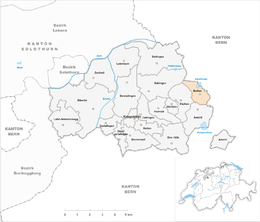Bolken
| Bolken | ||
|---|---|---|

Bolken village school house
|
||
|
||
| Coordinates: 47°12′N 7°40′E / 47.200°N 7.667°ECoordinates: 47°12′N 7°40′E / 47.200°N 7.667°E | ||
| Country | Switzerland | |
| Canton | Solothurn | |
| District | Wasseramt | |
| Area | ||
| • Total | 2.12 km2 (0.82 sq mi) | |
| Elevation | 496 m (1,627 ft) | |
| Population (Dec 2015) | ||
| • Total | 571 | |
| • Density | 270/km2 (700/sq mi) | |
| Postal code | 4556 | |
| SFOS number | 2514 | |
| Surrounded by | Aeschi, Etziken, Inkwil (BE), Niederönz (BE), Subingen | |
| Website |
http://www.bolken.ch SFSO statistics |
|
Bolken is a municipality in the district of Wasseramt in the canton of Solothurn in Switzerland.
Bolken is first mentioned in 1429 as ze Bollikon.
Bolken has an area, as of 2009[update], of 2.12 square kilometers (0.82 sq mi). Of this area, 1.37 km2 (0.53 sq mi) or 64.6% is used for agricultural purposes, while 0.46 km2 (0.18 sq mi) or 21.7% is forested. Of the rest of the land, 0.26 km2 (0.10 sq mi) or 12.3% is settled (buildings or roads), 0.04 km2 (9.9 acres) or 1.9% is either rivers or lakes.
Of the built up area, housing and buildings made up 6.6% and transportation infrastructure made up 5.7%. Out of the forested land, all of the forested land area is covered with heavy forests. Of the agricultural land, 55.2% is used for growing crops and 8.5% is pastures. All the water in the municipality is in lakes.
The municipality is located in the Wasseramt district, on the moraine landscape left behind by the Rhone glacier. It lies on the border with the Canton of Bern and consists of the haufendorf village (an irregular, unplanned and quite closely packed village, built around a central square) of Bolken and the Inkwilersee (Inkwiler lake).
The blazon of the municipal coat of arms is Gules a Ploughshare Argent between two Mullets of Five of the last in chief.
Bolken has a population (as of December 2015[update]) of 571. As of 2008[update], 4.5% of the population are resident foreign nationals. Over the last 10 years (1999–2009 ) the population has changed at a rate of 12%. It has changed at a rate of 3.7% due to migration and at a rate of 7.7% due to births and deaths.
...
Wikipedia




